This blog is written by Dan Mascola, the founder of Moosiko, an adaptive learning platform music students and teachers.
It’s the classic maximize ROI question: How can I increase the impact of my music program with my existing resources and without spending more money?
For the majority of the last 15 years, I’ve worked in the private sector, where improving ROI is a constant initiative. I’ve learned the best ways to improve ROI, no matter the discipline, is to look for efficiencies, measure progress through data, and rethink how you work. Funny thing is that I never started Moosiko to solve this problem in schools, in edtech, or in music. I started Moosiko to boost student engagement and make learning more fun. However, the challenges I’ve witnessed over the past year and how our product has evolved has opened up an opportunity to address the ROI problem head on benefiting districts, teachers, and students.
What if I told you that for the same dollar you have in your budget today, we can teach twice as many student and pay teachers 25% more. I believe this win-win-win is possible. I’ve spoken with hundreds of music teachers and district leaders this past year and the need to adapt and innovate has opened many doors, even though it has been a hard year for everyone.
In this blog I’ll talk about the unique solutions I’ve seen across many of our customers and how these translate into increased efficiencies, more visibility through data, and a rethinking how we teach that achieves a better ROI for school music programs.
Making Teachers More Efficient
We’re lucky in that we get to speak with hundreds of music teachers every year. The number one problem I hear from teachers is the challenge of teaching music in a group setting.
- “Some students come to class knowing a bit about music already, maybe their parents play”
- “Some students took the class last year and are already ahead”
- “Students learn at different speeds and I don’t want to hold back those that can skip ahead”
- “Students gravitate toward different types of music and its hard to personalize our curriculum”
This problem has only been amplified when half of the class is on Zoom and the other half is in-person.
Let’s first dive into the three main ways to learn an instrument:
- Self-Taught / 100% Asynchronous: This includes individual music learning programs, YouTube videos, working your way through a book, or just picking up an instrument and start messing around by yourself or with friends.
- Private Teacher / Coach: This one-on-one setting can include instruction from a friend/family member, private lessons (in-person or virtual), or homeschooled children.
- Group Classes: This one-to-many setting includes K-12 music classes, private music schools, or after school programs.
These various paths have their pros and cons as it relates to cost and effectiveness. Learning to play guitar watching YouTube videos is free, however students quickly get discouraged due to the overwhelming content and lack of quality control making it the least effective way to learn. Private, one-on-one instruction is by far the most effective, but also the most costly. We can see the relation between cost and effectiveness by plotting these learning paths on the following chart.
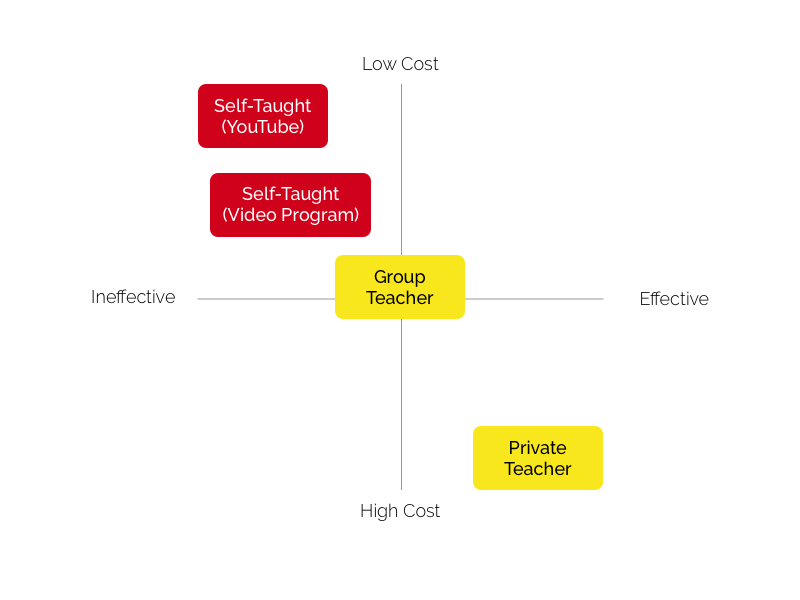
You can see that group teacher splits the difference between cost and effectiveness. While you get scale by teaching in a one-to-many environment, you lose personalization, which is reflected in the comments we hear from teachers and ultimately hinders student progress.
The ideal learning solution is a low cost, scalable solution that can provide personalized instruction at an individual level. This blend of synchronous and asynchronous learning using technology tools maintains the scale of a group setting while delivering a personalized experience for the student. Since edtech tools such as Moosiko provide the flexibility for students and teachers to learn at their own pace, we start to gain efficiencies.
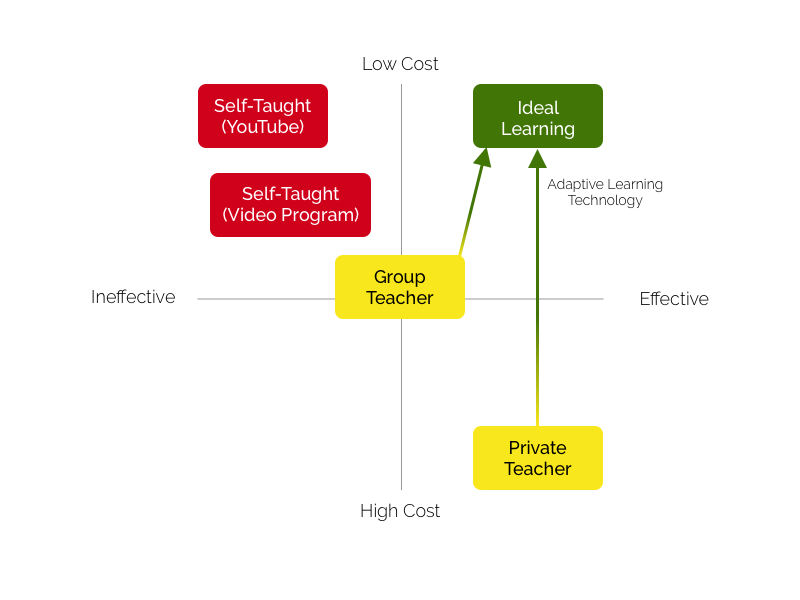
Ted Zalkind, a customer and band director in Yuba City California, got me thinking about this when he decided to take on 80 students for the spring semester instead of the typical 40. “The only reason I decided to take on 80 students this semester is because Moosiko helps me manage it”, he said. “I just don’t have to spend time hunting down resources, organizing files and videos, and catering to each and every student.”
This got me thinking that there is high value instruction time and low value instruction time for teachers.
High Value Instruction
- Set goals and direction for the class
- Motivate students
- Teaching new concepts
- “Reading the room” and responding as needed
- Help students that are struggling
- Evaluations, assessment, and feedback (as long as its not wasting class time)
Low Value Instruction
- Gathering resources
- Organizing files, assignments, videos
- Data gathering and data entry
- Transferring data from one program to another
- Taking notes on progress
- Evaluations, assessments, and feedback that wastes valuable class time
If we compare what Ted was doing before using Moosiko vs after, you can see his time is freed up for more high value instruction, making him a more efficient teacher allowing him to increase enrollment in his class.
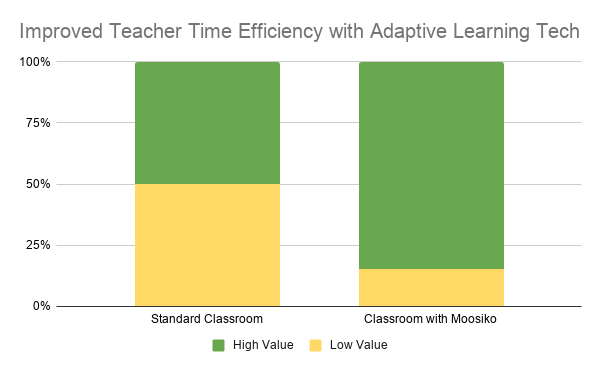
This efficiency gain saves Ted a lot of time and he choose to double the enrollment of his class. So increasing teacher efficiency is great but we’ve still got twice as many students to teach, support, and evaluate to ensure they are not only having fun but also performing at the necessary standards.
How can we ensure all students are learning the curriculum and hitting their end of year learning goals?
Making Teachers More Effective
During my time teaching guitar, there were always two questions almost every student asked me. They took some form of the following:
- “I know how to play G, C, D, and Em. What songs can I play?”
- “I know D, A, and G7 and I want to play Lady Gaga songs. What should I learn next?”
This is an easy question to help one student figure out but it’s not easy to answer for 30 or 80 students that all like different music and may all have different skillsets. This is why we typically default to a standard set of content for the entire class, because it is easier and more convenient for the teacher. Remember, the cost of scaling is losing student personalization.
Since every song, and basically all music, is just an arrangement of 12 notes, these questions are an easy data lookup problem software. Unfortunately there isn’t an accurate database of songs to help answer these questions for each student. So we built one.
As teachers, and students, are going through their curriculum, they can easily look up songs based on specific chords, keys, and difficulty making it easy for students to find relevant songs for their skillset and style:
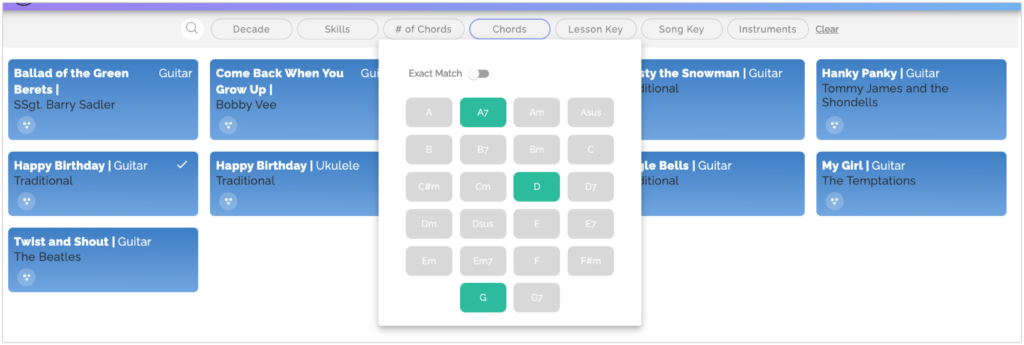
Easily Lookup Songs by Chords and Skills
As students learn songs, we’ve made it easy to capture progress so teachers can track skills for each student and see their practice time. This detailed skill and engagement data allows teacher to quickly see who is struggling and unengaged so they can provide pinpointed assistance. Focusing time on the right students in the right areas can help teachers be more effective at reaching learning goals.

Track Student Skills and Practice Time
Formative Assessments on Steroids Using Built-In Video
During COVID virtual learning, we built a student video tool that allowed students to easily capture a skill they were practicing or a song. This was an essential feature when everyone was remote but we learned it helped make teachers a lot more effective when they returned to the classroom as well.
- Individual student assessment takes a lot of time (5 minutes / student * 30 students = 2+ hours). Videos allow teachers to watch assignments when it is convenient for them
- Some students get stage-fright with the teacher staring down on them for a weekly performance quiz. Videos allows students to record themselves when they are comfortable and ready
- Students often are their harshest critic. When students watch themselves on video, they tend to want to do better, and will rerecord themselves multiple times to improve their performance. This self-improvement behavior has so many transferable life skills.
- Teachers and students can see a visual log of performance from the beginning of the year to the end. These before/after videos quickly convey just how much students are learning and provide a great sense of accomplishment.
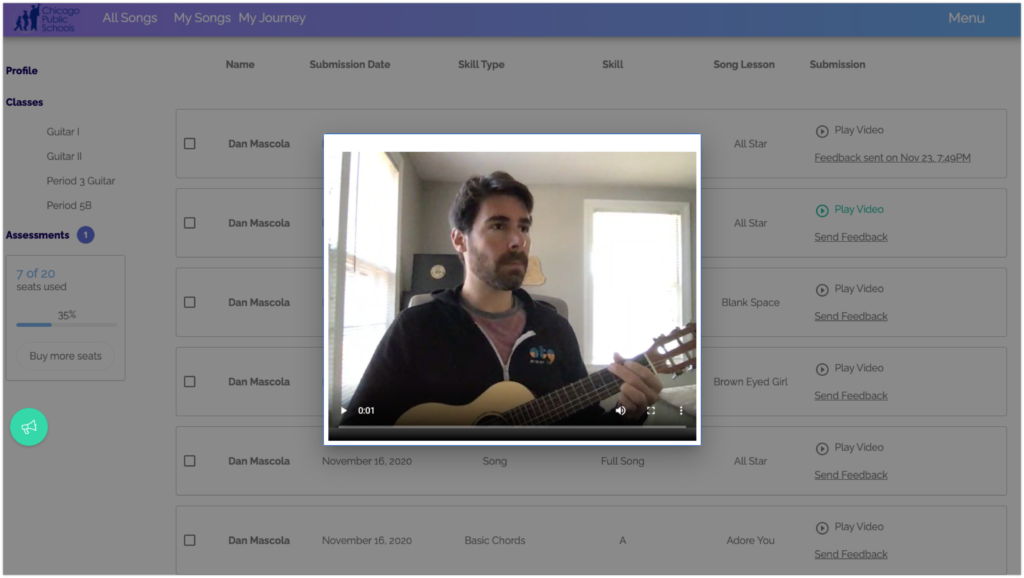
Built-In Video Recording Makes Student Assessment Easy
The built-in video experience allows students to capture short, 10-second clips throughout their learning journey so teachers can quickly identify micro-wins and micro-mistakes and make corrections before bad habits form. This granular visibility not only provides valuable feedback for students but helps teachers focus on what matters.
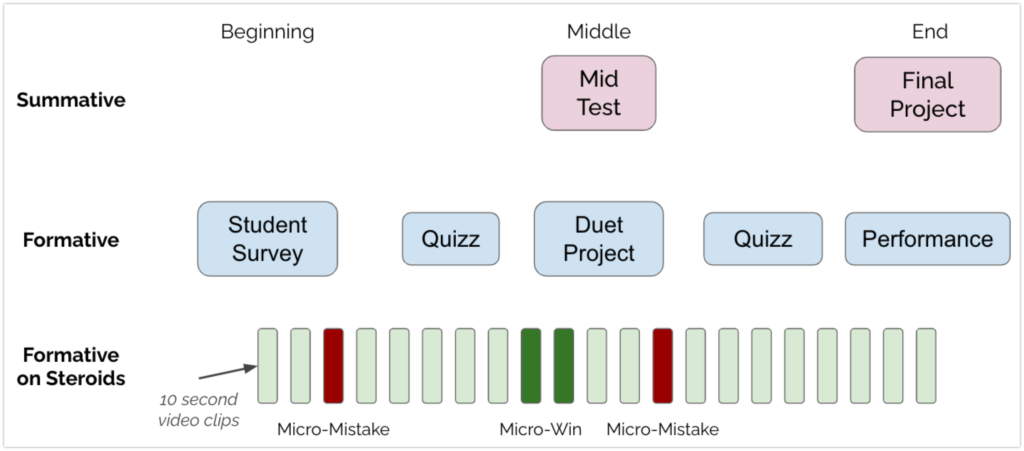
Short Videos Clips Provides Visibility into Mirco-wins and Micro-Mistakes
By providing more visibility through skill tracking, engagement metrics, and videos, teachers gain the necessary insights to focus on the real challenges with the class or individual students, ultimately making every student more likely to meet the stated learning goals.
How are these efficiency and effectiveness gains leading to real impact and more access for students?
Rethinking How We Teach
Yes the 20/21 school year was tough, but oftentimes positive change an innovation comes when an environment gets stressed. One of the necessary changes we had to adapt to was expanding our teaching modalities to include virtual and hybrid environments, in addition to the standard in-person. These new modalities come with their challenges but also a plethora of benefits, typically supported through technology. We see that these three modalities that can exist together:
- In-Person: The traditional, pre-COVID classroom. Its strength is super high engagement and support. Its weakness is that enrollment is limited by the physical space.
- Remote: This could be fully virtual or some hybrid model that uses a mix of synchronous and asynchronous resources and tools. Strength is that it allows for an expanded enrollment. Weakness is that it is less personal and thus participation will be worse compared to in-person.
- Office Hours Only: We’ve seen this used in only a few schools but it is very promising. This type of learning is 100% asynchronous, using tools like Moosiko, but allows students to hop in during teacher “office hours” which could be virtual or remote. Strength is that enrollment can be expanded to all students in the district while still allowing the pinpointed help when students need it. Weakness is that participation will be the poorest, especially for students not as self-motivated.
If a single teacher combines all three of these modalities, we can start to see the impact. In the example below, the teacher has more than double the impact compared to the traditional in-person classes.
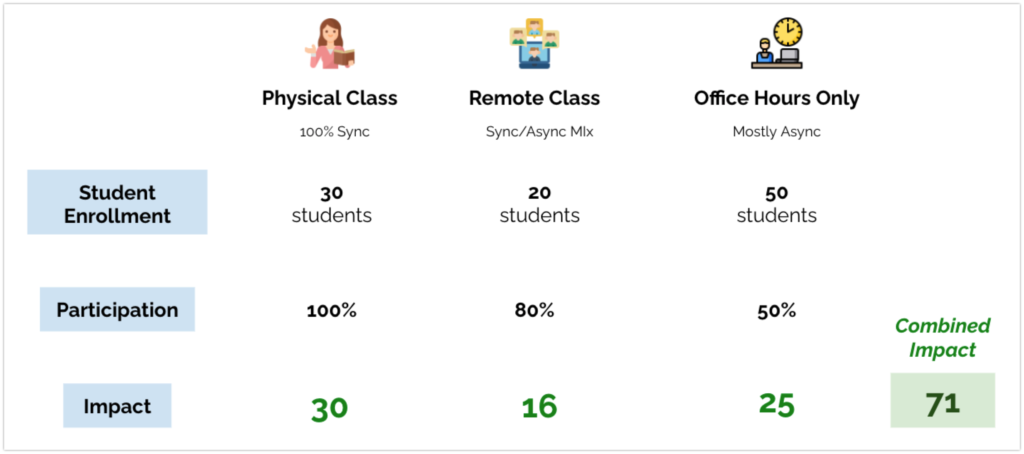
Expanded Teaching Modalities Allow for Great Impact per Teacher
Thinking of your music program using multiple modalities like this allows you to support 2x – 3x more students with the same staff resources.
Win-Win-Win
For meaningful change to happen, goal alignment is critical. Everyone needs to be marching in the same direction because working through big changes like this can be rocky. Looking at each constituent we can make some claims about objectives:
- Students want to learn music. And they want it to be fun, relevant, and accessible for their generation and lifestyle.
- Teachers want their jobs to be easier and want to get paid more.
- Districts want to increase enrollment size and have a greater impact with the same, or less, resources and budget.
Using technology and focusing on the core principles of increasing efficiencies, providing more visibility through data, and rethinking how we teach, we believe that a win-win-win is possible. School districts can have a greater impact with their music program making it more accessible and relevant for students while teachers are able to take on more students with the same effort so they can get paid more.
We’ve got a long ways to go before this shift becomes widespread not only in music but throughout all education. However, what excites me is that we’re already seeing lots of these benefits as teachers adapt more technology tools and experiment with new ways of teaching. I believe that schools and programs that explore these new ideas will achieve success all around over the next few years.
Dan Mascola is the founder of Moosiko. He performs PD workshops and speaks extensively on topics like adaptive learning technology, music edtech tools, and modern music / band. Visit our press page for more info of feel free to reach out to Dan directly at [email protected].
